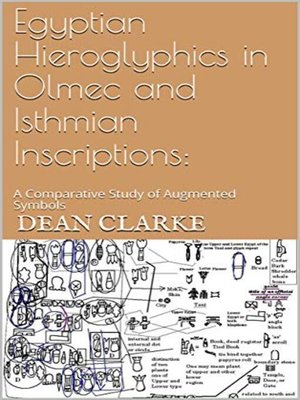Egyptian Hieroglyphics in Olmec and Isthmian Inscriptions
ebook ∣ A Comparative Study of Augmented Symbols: A Comparative Study of Augmented Symbols
By Dean Clarke

Sign up to save your library
With an OverDrive account, you can save your favorite libraries for at-a-glance information about availability. Find out more about OverDrive accounts.
Find this title in Libby, the library reading app by OverDrive.



Search for a digital library with this title
Title found at these libraries:
| Library Name | Distance |
|---|---|
| Loading... |
This book studies one of the oldest language scripts in the New World in regards to the Central America and Lower Mexico cultures called the Cascajal Script stone on a Stele like border stone. The author compares separate place name examples in Mexico City of late Isthmian or Epi Olmec like culture and goes backwards to the stone script to explain the persistence of language patterns borrowed by cultures over time in the ancestral sense of the term i.e. passed down myths, local folklore or beliefs. Clarke examines the script like a social anthropologist but with a part linguistic patterns of expressions not usually noted by both Archaeologists or Maya scholars in regards to a separate system of reading by parallel Egyptian Hieroglyph system comparisons. This is not a work the same as a Le Plongeon attempts of the linguistic past who tried to tie Egyptian symbols and analogies with a culture he knew very little about. Clarke shows why and how that mistake can be avoided and at the same time proper questions of similar systems addressed. He looks at the script of Cascajal to its nearest sign equivalent of Egyptian then goes back to other objects that are adjacent to the each script and explain why they are correlative which he calls the 'secondary pattern' or depth of interpretation. Clarke in the book does not want to distract scholars but wants to add to their diction and meaning system with correlative groupings found in both kingdom and agriculture based city powers of 'dual and twin' dedications. Clarke then shows how and why this is even predominate in the Cherokee, Aztec and Maya Calendar sign systems of the dual twins or brothers as Hero Cult rulers of the ancient past that introduced these systems. This is one amazing book if not for Clarke's examples of Egyptian crowns of the Pharaohs used by Olmec and Isthmian Chiefs! Clarke then explains why this mimic occured with the Olmec which Clarke believes are more a African sea trade group them a indigenous group alone thought to be of the Pacific Coast landings and invasion. Clarke makes a strong argument 'rubber' was exploited in Africa in ancient times in almost a similar timeline as the ancient indians in the America's.







